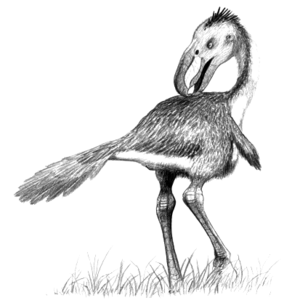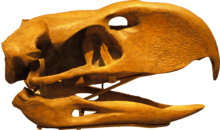Phorusrhacidae
| Phorusrhacidae | ||||||||||||
|---|---|---|---|---|---|---|---|---|---|---|---|---|

|
||||||||||||
| Temporal occurrence | ||||||||||||
| Upper Paleocene to Upper Pleistocene | ||||||||||||
| 58.7 million years to 18,000 years | ||||||||||||
| Locations | ||||||||||||
| Systematics | ||||||||||||
|
||||||||||||
| Scientific name | ||||||||||||
| Phorusrhacidae | ||||||||||||
| Ameghino , 1889 |

The Phorusrhacidae , also terror birds , were up to 2.4 m, possibly also up to 3 m large, ground-dwelling and mostly flightless birds, whose fossils were found mainly in South America. They assumed the role of top predators during the Paleogene and Neogene in South America . The only recent birds that are closely related to them are the South American Seriemas (Cariamidae). Ten genera and 25 species have been described. The oldest species is Paleopsilopterus itaboraiensis from the Middle Paleocene (Itaboraium) of Rio de Janeiro ( Brazil ).
Family history and distribution
The first Phorusrhacid Phorusrhacos longissimus was described in 1887 by the Argentine naturalist Florentino Ameghino after a find in the Argentine province of Santa Cruz . Later finds were made in other parts of Argentina, in Bolivia and Brazil. Two single, three-toed 18 cm long footprints from the time of 55 million years ago are known from the Antarctic King George Island , which are either assigned to a phorus rhacid or a ratite . In addition, the front part of a Phorus rhacoid beak was found in 40 million year old layers on Seymour Island . Also from the Aquitaine basin in France , a phorus rhacoid was reported with the 38 to 35 million year old Ameghinornis , which was only as big as a Seriema and apparently could still fly. However, Alvarenga and Höfling (2003) exclude this find from the group of Phorusrhacidae, and the family only includes taxa from South America and Titanis walleri from the Upper Pliocene and Lower Pleistocene of North America. Today Ameghinornis and its relatives are placed in a separate family, the Ameghinornithidae . In 2011, the genus Lavocatavis , a possible Phorusrhacid from the early or middle Eocene of Morocco , was described on the basis of a single thigh bone . However, contradicting features or alternative interpretations exist for all finds outside the Americas, so that an occurrence in the Old World is extremely doubtful.
With the emergence of the Isthmus of Panama , d. H. the formation of a land bridge between North and South America , the Phorusrhaciden therefore spread to North America. As stratigraphically youngest Fund was long the aforementioned 2.5 to 1.5 million years ago Titanis walleri from North Florida. In 2010, a research group led by Herculano Alvarenga published phorus rhacid remains from Uruguay that have an absolute age of only 17,620 ± 100 years. This corresponds chronostratigraphically the top Pleistocene . Another find of Psilopterus from Uruguay with an OSL age of 96.040 ± 6300 years, published in 2018 by Jones et al. was published, probably proves the survival of the group into the Upper Pleistocene.
features
Phorusrhaciden had a strong trunk, a high beak adapted to carnal food, a relatively long neck and long, muscular hind legs. In most species, their stub wings were only used to keep their balance while running. The flightless animals reached a body weight of about 45 to 180 kg , were 0.8 to 2.4 meters, possibly up to 3 meters high and achieved running speeds of over 50 km / h .
Way of life
The Phorusrhaciden took in South America together with the carnivorous marsupial mammals of the order Sparassodonta and the terrestrial crocodiles of the family Sebecidae the role of the missing predators (Carnivora). While the other two groups were rather slow, most terror birds specialized in quick prey in the dry forests and savannas of South America , which were becoming increasingly open 27 million years ago . At the same time they began to grow enormously. Five million years ago they had completely displaced the predatory marsupials from the savannas. The larger species could kill prey the size of an antelope with kicks. When attacked, the birds also used their large beaked heads like an ax. Instead of biting into the victim, they hit fast and precise. However, there were also clumsily built and slow terror birds that probably fed on carrion. In South America, the larger Phorusrhacids became extinct at the end of the Pliocene . Very little is known about the cause of their extinction. It is believed that the Phorusrhacids were no match for the newly immigrating saber-toothed cats (Machairodontinae) and dogs (Canidae). But smaller forms survived into the Upper Pleistocene.
External system
As obviously carnivorous birds, the Phorusrhaciden were initially placed among the birds of prey shortly after their discovery . But as early as 1899, Charles W. Andrews from the British Museum in London was able to prove that they were relatives of the Seriemas (Cariamidae) still living in the South American savannahs today . Other close relatives are the extinct families Bathornithidae from North America and the Idiornithidae from Europe. Both groups lived from the Eocene to the early Oligocene . All four families were traditionally placed in the order of the crane birds (Gruiformes), and there combined into a superfamily Cariamoidea or a suborder Cariamae. Since more recent research based on comparative DNA sequence analyzes question the monophyly of the crane-like and see the Seriemas out of order, the affiliation of the Phorusrhacidae to the crane-like is now doubtful and in more recent publications they are used together with the Seriemas of the order Cariamiformes assigned.
Internal system
According to Alvarenga and Höfling (2003), the Phorusrhacidae are divided into five subfamilies , 14 genera and 18 species. They reached their greatest diversity during the Lower Miocene .
Subfamily Physornithinae
The subfamily Physornithinae includes large to very large species. The birds were heavy build, short legs and large beaks, and may have been scavengers . Fossils from this group are 27 to 17 million years old.
- Genus Paraphysornis (Upper Oligocene to Lower Miocene of São Paulo , Brazil)
- Genus Physornis (Middle to Upper Oligocene of Santa Cruz , Argentina)
Subfamily Phorusrhacinae
The subfamily Phorusrhacinae includes medium-sized to very large species with a body height of up to 2.4 or even up to 3 meters and a weight of up to 180 kg. They were quick predators. Fossils from this group are 27 to 1.8 million years old.
- Genus Devincenzia (Upper Miocene to Lower Pliocene of Northeast Argentina and Arroyo Roman, Uruguay )
- Genus Kelenken (Middle Miocene of Río Negro, Argentina (currently the largest known Phorusrhacid))
- Genus Phorusrhacos (Lower to Middle Miocene)
- Genus Titanis (Pliocene to Lower Pleistocene)
Subfamily Patagornithinae
The subfamily Patagornithinae includes medium-sized species, about 1.5 meters high.
- Genus Patagornis (Lower to Middle Miocene of Santa Cruz, Argentina) including Morenomerceraria , Palaeociconia , Tolmodus
- Genus Andrewsornis (Middle to Upper Oligocene of southern Argentina)
- Genus Andalgalornis (Upper Miocene to Lower Pliocene)
Subfamily Psilopterinae
The smallest species belong to the subfamily Psilopterinae, with a height of about one meter. They may have retained some remaining ability to fly. Fossils from this group are 63 million to 96.040 ± 6300 years old. The smallest known terror bird Psilopterus lemoinei belongs to this subfamily. He was the size of a harpy and weighed 8 kg.
- Genus Psilopterus (Middle Oligocene to Upper Pleistocene of southern and eastern Argentina)
- Genus Procariama (Upper Miocene to Lower Pliocene of Catamarca, Argentina)
- Genus Paleopsilopterus (Middle Paleocene of Itaboraí, Brazil)
Subfamily Mesembriornithinae
The subfamily Mesembriornithinae contains two medium-sized genera about 1 to 1.5 meters high.
- Genus Llallawavis (Upper Pliocene)
- Genus Mesembriornis (Upper Miocene to Upper Pliocene)
Other genera and miscellaneous
- Genus Patagorhacos (Lower Miocene of Northern Patagonia)
The North African genus Lavocatavis , only described in 2011, is not assigned to any subfamily. Originally Physornis and Paraphysornis belonged together with Brontornis to the subfamily Brontornithinae. However, a revision of the genus Brontornis in 2007 revealed a closer relationship with the geese birds , whereupon Brontornis is now placed at the base of this group and the new subfamily Physornithinae of the terror birds was introduced.
literature
- Herculano Alvarenga , Luis Chiappe and Sara Bertelli: Phorusrhacids: the Terror Birds, in Living Dinosaurs: The Evolutionary History of Modern Birds. Chichester 2011 ( online publication ), ISBN 978-0-470-65666-2 .
- Alan Feduccia : The Origin and Evolution of the Birds. 2nd ed., Yale University Press, New Haven and London 1999, ISBN 0-300-07861-7 .
- Larry G. Marshall: Giant Cranes - Predators of South America in the Tertiary. In: Spectrum of Science , Dossier 1/2005, ISSN 0947-7934 , ISBN 3-936278-90-3 .
Individual evidence
- ↑ a b Herculano MF Alvarenga, Washington Jones and Andrés Rinderknecht: The youngest record of phorusrhacid birds (Aves, Phorusrhacidae) from the late Pleistocene of Uruguay. New yearbook for geology and palaeontology treatises, 256/2: 229–234, Stuttgart. doi: 10.1127 / 0077-7749 / 2010/0052 .
- ↑ a b c Cécile Mourer-Chauviré, Rodolphe Tabuce, M'hammed Mahboubi, Mohammed Adaci & Mustapha Bensalah: A Phororhacoid bird from the Eocene of Africa. Natural Sciences (2011) 98: 815-823, doi: 10.1007 / s00114-011-0829-5 .
- ↑ a b Herculano MF Alvarenga and Elizabeth Höfling: Systematic revision of the Phorusrhacidae (Aves: Ralliformes) . Papéis Avulsos de Zoologia, 43 (4): 55-91, Sao Paulo 2003. PDF .
- ↑ Dieter S. Peters: The fossil family Ameghinornithidae (Mourer-Chauviré 1981): a short synopsis. Journal of Ornithology, Volume 148, Number 1 / January 2007 doi: 10.1007 / s10336-006-0095-z
- ↑ Gerald Mayr: Avian Evolution: The Fossil Record of Birds and its Paleobiological Significance. John Wiley & Sons, 2016. ISBN 978-1-119-02073-8 (section “Were there phorusrhacids outside the Americas?”).
- ↑ a b c Washington Jones, Andrés Rinderknecht, Herculano Alvarenga, Felipe Montenegro & Martín Ubilla: The last terror birds (Aves, Phorusrhacidae): new evidence from the late Pleistocene of Uruguay. Palaeontological Journal, 92: 365–372, 2018 doi: 10.1007 / s12542-017-0388-y .
- ↑ Alvarenga and Höfling, p. 59.
- ↑ Luis M. Chiappe and Sara Bertelli: Skull morphology of giant terror birds. These monstrous birds were probably more agile and less portly than previously thought. Nature 443, 2006, p. 929.
- ↑ Article “The Terror of Terror Birds” at Wissenschaft.de .
- ↑ Article "Terror birds hunted with the boxing strategy" at H-AGE.net .
- ↑ Livezey, BC and RL Zusi (2007): Higher-order phylogeny of modern birds (Theropoda, Aves: Neornithes) based on comparative anatomy. II. Analysis and discussion, Zool. J. Linn. Soc. 149, 1-95.
- ^ Robert L. Carroll : Paläontologie und Evolution der Vertbeltiere , Thieme, Stuttgart (1993), ISBN 3-13-774401-6 .
- ↑ Hackett et al .: A Phylogenomic Study of Birds Reveals Their Evolutionary History . Science 27 June 2008: Vol. 320. no. 5884, pp. 1763–1768 doi: 10.1126 / science.1157704
- ↑ Federico J. Degrange & Claudia P. Tambussi: Re-Examination of Psilopterus lemoinei (Aves, Phorusrhacidae), a Late Early Miocene Little Terror Bird from Patagonia (Argentina). Journal of Vertebrate Paleontology, Volume 31, Issue 5, Pages 1080-1092, 2011, doi: 10.1080 / 02724634.2011.595466 .
- ↑ Alvarenga and Höfling, p. 59
- ↑ a b Frederico L. Agnolin: Brontornis burmeisteri Moreno & Mercerat, un Anseriformes (Aves) gigante del Mioceno Medio de Patagonia, Argentina. Revista del Museo Argentino de Ciencias Naturales Nueva Series 9, 2007, pp. 15-25.
- ^ Sara Bertelli, Luis M. Chiappe and Claudia Tambussi: A new phorusrhacid (Aves: Cariamae) from the Middle Miocene of Patagonia, Argentina. Journal of Vertebrate Paleontology, 27 (2): 409-419, Deerfield, IL 2007.
- ↑ Federico J. Degrange, Claudia P. Tambussi, Matías L. Taglioretti, Alejandro Dondas, Fernando Scaglia. A new Mesembriornithinae (Aves, Phorusrhacidae) provides new insights into the phylogeny and sensory capabilities of terror birds. Journal of Vertebrate Paleontology, 2015; 35 (2): e912656 doi: 10.1080 / 02724634.2014.912656 .
- ↑ Federico L. Agnolin and Pablo Chafrat: New fossil bird remains from the Chichinales Formation (Early Miocene) of northern Patagonia, Argentina. Annales du Paléontologie, 2015 [1] .



